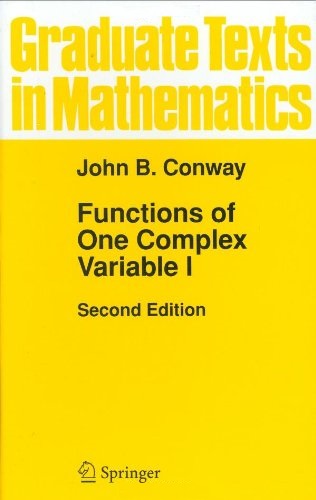 Carl F. Gauss, 1777-1855 |
 Augustin L. Cauchy, 1789-1857 |
 G. F. Bernhard Riemann, 1826-1866 |
 Carl F. Gauss, 1777-1855 |
 Augustin L. Cauchy, 1789-1857 |
 G. F. Bernhard Riemann, 1826-1866 |

COURSE: MATH 5510
TIME: 12:45-2:05 TR; PLACE: Room 205 of Gilbreath Hall; CALL# 84721
INSTRUCTOR: Dr. Robert Gardner; OFFICE: Room 308F of Gilbreath Hall
OFFICE HOURS: T.B.A.; PHONE: 439-6979 (Math Office 439-4349)
E-MAIL: gardnerr@etsu.edu
WEBPAGE: www.etsu.edu/math/gardner/gardner.htm (see my webpage for a copy of this course syllabus and updates for the course).
TEXT: Functions of One Complex Variable, Second Edition, by John Conway.

PREREQUISITE:Formally, the prerequisite is an undergraduate real analysis class or advanced calculus class. Practically, what is necessary is some exposure to (and a reasonable recollection of) the topology of R (open and closed sets, limit points, connectedness, compactness, completeness, lub and sup, glb and inf, sequences and series of real numbers, convergence, uniform convergence, comparison tests, Cauchy sequences), and properties of functions of a real variable (continuity, differentiability, power series representation). It is also assumed that the student has been exposed to some elementary properties of the complex numbers (algebra, geometry, roots of unity, modulus). Even some of the topics will be addressed in this class.
CLASS NOTES: We will use overheads for component of the lecture consisting of definitions, statements of theorems, and some examples. I will use the white board for additional examples and proofs of theorems. Copies of the notes are online at:
ABOUT THE COURSE: Complex analysis is basically the study of analytic functions. As we will see, a function of a complex variable is often much better behaved than a function of a real variable! We will introduce the complex numbers as an extension of the real numbers. We explore the complex plane and give a geometric interpretation of results whenever possible. We study metric spaces in general, but with an eye towards the complex field. Analytic functions are defined, their series representations are explored, and Mobius transformation are analyzed. Finally, we introduce integration of complex functions, prove the Fundamental Theorem of Algebra, and the Maximum Modulus Theorem. If time permits, I will discuss some of my research results which are related to topics in the class. We may have the opportunity to briefly explore applications of this material, but this is definitely a pure math class and our concentration will be on theory.
OUTLINE:
Our tentative outline is:
Introduction. Introduction to Math Philosophy and Meaning, formalism, David Hilbert, Gottlob Frege, Bertrand Russell, Principia Mathematica, Russell's Paradox, Kurt Godel, well-formed formulas, complete axiomatic systems, undecidability, misinterpretations of undecidability, Adam Sokal, Peano's axioms of arithmetic.
Chapter 1. The Complex Number System: Introduction to the
complex plane, real and imaginary parts, modulus, polar representation,
extended complex plane, Riemann sphere.
Chapter 2. Metric Spaces and Topology of C: Extensions of
several ideas from R to C and other metric spaces, open and
closed sets, connectedness, sequences, completeness, compact sets,
continuity, convergence, uniform convergence.
Chapter 3. Elementary Properties and Examples of Analytic
Functions: Series, convergence of series, differentiability, analytic
functions, mappings, Mobius transformations.
Chapter 4. Complex Integration: Riemann-Stieltjes integrals,
power series, zeros of analytic functions, Fundamental Theorem of Algebra,
Maximum Modulus Theorem, winding number, Cauchy's Integral Formula,
properties of path integrals, Open Mapping Theorem.
(My plan for Complex Analysis 2 [MATH 5520] is to cover chapters V, VI, VII, IX, and XI.)
GRADING: Homework (H) to be turned in will be assigned regularly. We will have two tests (T1 and T2) and your average will be computed as follows:
A NOTE ABOUT HOMEWORK: You must show all details on the homework problems!!! Justify every step and claim you make - this is how you convince me that you know what you are doing. While I suspect that you may work with each other on the homework problems (in fact, I encourage you to), I expect that the work you turn in is your own and that you understand it. Some of the homework problems are fairly standard for this class, and you may find proofs online or in an online version of the solutions manual. The online proofs may not be done with the notation, definitions, and specific methods which we are developing and, therefore, are not acceptable for this class. If I get homework from two (or more) of you that is virtually identical, then neither of you will get any credit. If you copy homework solutions from an online source, then you will get no credit. These are examples of plagiarism and I will have to act on this as spelled out on ETSU's "Academic Integrity @ ETSU" webpage: http://www.etsu.edu/academicintegrity/faculty.aspx (last accessed 7/21/2013). To avoid this, do not copy homework and turn it in as your own!!! Even if you collaborate with someone, if you write the homework problems out in such a way that you understand all of the little steps and details, then it will be unique and your own work.
IMPORTANT DATES:
Monday, September 2 = Labor Day Holiday.
Friday, September 6 = Last day to drop without a grade of "W."
Monday and Tuesday, October 14 and 15 = Fall Break Holiday.
Thursday, October 24 = Test 1 (Chapters 1 and 2, and supplements)
Monday, October 21 = Last day to drop without dean's permission.
Thursday and Friday, November 28 and 29 = Thanksgiving Holiday.
Wednesday, December 4 = Last day to withdraw from the university.
Friday, December 6 = Last day of class.
Thursday, December 12 = Comprehensive final, 1:20 a.m. to 3:20 p.m.
OTHER RESOURCES. The following may be of interest:
HOMEWORK.The following homework is assigned:
Return to Dr. Bob's webpage
Last updated: November 25, 2013.